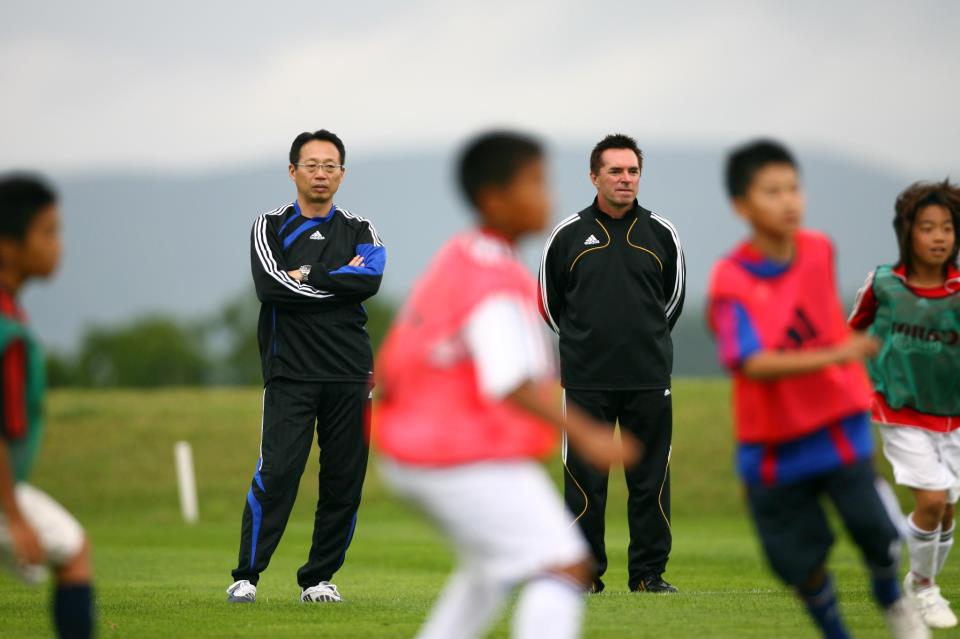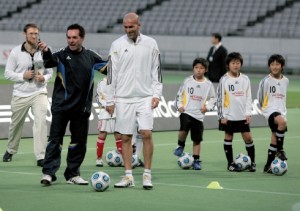Tom Byer is arguably the greatest pioneer of grassroots football this century. Situated at the heart of Japanese football’s rise Tomsan has become an icon in the Japanese youth soccer world, appearing in over 2,000 development soccer events and Tomsan’s Soccer techniques, the longest running Corner (over 13 years) inside the Ohasuta Program, showing each weekday morning on national television. In 1998 Tom was the first and only youth soccer coach to receive the Adidas “Golden Boot Award” for outstanding contributions to the game.
To put simply, if you don’t know Tom Byer, you don’t know international grassroots football.
Last week the grassroots guru himself was kind enough to share some thoughts and experiences with Grassroots about the development of football in Japan and China.
For background info on Tom Byer
– Your story in Japan is amazing, before coming did you ever imagine spending 20 years in the country and becoming an icon in the sport?
T-I really thought that I would wind up back in the United States playing there some day. But the MLS didn’t start until 1994 and by that time I was finished as a player and 34 years old. I hadn’t thought I would become so popular in Japan until I started appearing on national television each weekday morning. Up until that time I had spent a lot of time traveling throughout Japan doing football clinics, but the national media exposure propelled me into a different stratosphere!
-Japanese Manga and Television has made Tomsan a household name. What’s the typical day like for a Japanese Football Icon?
I don’t have a typical Monday to Friday 9 to 5 schedule, so depending on the day my routine can vary. I spend some time down in my office near Ginza and I also attend to the TB Academy (Tom’s namesake), located in Soga, Chiba. I like to be around the kids and see how they are progressing. I also do some of
the coaching as well on occasion. I try to avoid riding any trains during peak times that kids are on them, for obvious reasons! But I have plenty to do by way of meetings, interviews, and many other activities. For many years most weekends have been spent traveling throughout the 47 prefectures of Japan conducting soccer clinics. I’m fortunate to have many friends throughout the entire country!
– How has the thinking, plan, and infrastructure of Japanese grassroots football developed since its inception?
When I first arrived in Japan the mentality was that football should be coached and administered by volunteers, and to a certain extent it still is in most areas. Now you will find very experienced people coaching, but also very inexperienced people. So kids/families, etc., sometimes have a lot of luck to live in a certain area with good coaching and organization. So I identified early that teaching technique to kids aged 6-12 was the foundation upon which you build all the other parts of the game on. We developed a commercial business which would support the concept of delivering quality coaching focusing on improving technique. We also made sure that everyone had access to this content, through as many channels as possible. We created soccer schools where kids pay to play. We held many events sponsored by big brands, free of charge. We created products such as VHS and DVD’s with technical content. We tied up with football magazines to deliver it. I presented a one point technical lesson each weekday morning for 13 years, and we tied up with Yahoo to provide content free of charge to anyone who had a computer. This educated and highlighted the importance of focusing on technique and provided many people with content they could use during their own coaching sessions. We also empowered players to practice on their own. So I believe we were a big game changer for Japan in changing the way the game is coached. Since that time there have been many copycats, which is actually a good thing for Japan, more emphasis on teaching technique can only be a good thing and I think we are starting to see the work we have done for the past 20 year now paying off on the pitch when Japan plays.
-What are the current philosophy and main goals of T3?
T-The current philosophy for T3 is to try to improve as many players as possible in hopes of continuing to raise the level of Japanese players. My philosophy is simple, improve the worst player to become better which in turn will put pressure on the very best players to become better. By making the average player much better so that the country is very strong in the core. You see that now in Japanese football, last year Kashiwa Reysol was promoted from the J2 to J1 and won the J1 Championship. This is relatively an unheard of feat! Also, the Emperors Cup Final featured for the first time ever, 2 teams from the J2. So this is telling me that Japan has much depth. So it needs to continue down the same path of development. I am also concerned and committed at helping other Asian countries catch up, so we are working on a few different projects around the region.
– Recent successes for Japanese men’s and women’s national teams have gathered lots of headlines, how much do you think the grassroots system directly affected this?
Without a doubt the grassroots system has been a game changer for Japan. There has been heavy investment by both the private second, J-League, JFA and government. Where there is huge investment into youth you will find the best national team programs in the world!
– The JFA has a plan to be FIFA emphatically ranked in the world’s top 10 by 2020, and to win the FIFA world cup by 2050. What’s do you expect of Japanese Football in the future?
T-I think that both goals are doable. They can definitely be a top 10 team and there is no reason they can not win a World Cup within the next 38 years or sooner. Japan has finally found its own style of football which is recognizable throughout the world.
-You’ve been to visit China several times now; what are your thoughts on the Chinese Super League, Chinese grassroots system, and overall impression of Chinese soccer?
T-I haven’t had much chance to watch too many Chinese Super League games but my impression from what I have watched and the National Team is, they lack some of the basics. The Chinese players also seem to lack the mental toughness to deal with the many different conditions during a game. It seems they become quite frustrated when are behind and could adapt a stronger mentality to endure a full 90 minutes. But surely lack of technique can cause lots of problems for a players concentration. I do believe there is hope. With such a huge population and so many of them young children, there is no reason why they can not compete with the top countries in the world eventually. But the key will be to focus on Grassroots/Youth Development. This has got to be a priority and start at the very young ages, 5,6,7 year olds.

Tom with Takeshi Okada, current manager of Hangzhou Greentown.Can the two leave a legacy of development and success in Chinese football?
– Chinese Grassroots Football is full of excuses- (Single Child Law, Education System, Lack of Public Playing Space, etc.) how do you think player development at the grassroots level can overcome such obstacles?
T-In todays world children are influenced by media and what other friends like to do. So I believe that the media can create an environment where children become interested in football or any sport for that matter. I am always amazed that the school facilities for kids in China are far superior to Japan’s. Many astro turf fields and lots of space. The CFA and Chinese government need to utilize the media more in popularizing the Sport!
– What’s the most important message you would tell a Chinese soccer player or soccer coach?
T-For the players, you must have fun while playing and learn at a very young age how to do many things with a ball. Practice is extremely important and not just for football but everything. You can not master anything if you don’t practice. For coaches, they need to create an environment where kids will have fun first and learn second. Focus on technique during the formative ages, 5,6 7, 8, etc., so that the kids have the tools to succeed in a game. Bottom line, if the kids aren’t enjoying they will quit!
-What does the future hold for T3 establishing more of a presence in Chinese soccer?
T-I’ve done some work with Li Wei Feng, captain of the Chinese National Team, who has become a friend. So I could be doing more work with him in the future. I’ve also had some discussions that are ongoing with the CFA to take on an advisory role for Grassroots. So I’m engaged but only one person trying to do many things!
– Any closing comments on Chinese football?
I can’t emphasize enough how important it is to focus on youth. There are no shortcuts and I know the professional clubs and owners need to focus on winning games, but these same clubs need to have a commitment to developing the game as well. It just makes good business sense that you should develop you own players so you don’t have to spend millions of dollars buying them.



